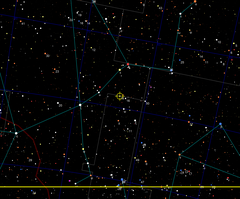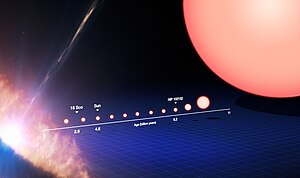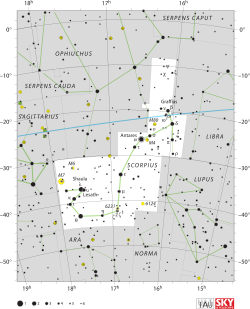18 Scorpii
| Observation data EpochJ2000.0EquinoxJ2000.0 | |
|---|---|
| Constellation | Scorpius |
| Right ascension | 16h15m37.27028s[1] |
| Declination | –08° 22′ 09.9821″[1] |
| Apparent magnitude(V) | 5.503[2] |
| Characteristics | |
| Spectral type | G2 Va[3] |
| U−Bcolor index | +0.18[4] |
| B−Vcolor index | +0.64[4] |
| Variable type | Sun-like[5] |
| Astrometry | |
| Radial velocity(Rv) | 11.71±0.12[1]km/s |
| Proper motion(μ) | RA:232.230mas/yr[1] Dec.:−495.378mas/yr[1] |
| Parallax(π) | 70.7371 ± 0.0631mas[1] |
| Distance | 46.11 ± 0.04ly (14.14 ± 0.01pc) |
| Absolute magnitude(MV) | 4.77[2] |
| Details[6] | |
| Mass | 1.03±0.03M☉ |
| Radius | 1.010±0.009R☉ |
| Luminosity | 1.0438±0.0120L☉ |
| Surface gravity(logg) | 4.448±0.012cgs |
| Temperature | 5,817±4K |
| Metallicity[Fe/H] | 0.04±0.024[7]dex |
| Rotation | 22.7±0.5d[8] |
| Age | 2.9±0.5[9]Gyr 5.64 or 7.18Gyr |
| Other designations | |
| Database references | |
| SIMBAD | data |
| Exoplanet Archive | data |
18 Scorpiiis a solitarystarlocated at a distance of some 46.1light-years(14.13parsecs) from theSunat the northern edge of theScorpius constellation.It has anapparent visual magnitudeof 5.5,[2]which isbright enoughto be seen with the naked eye outside of urban areas. The star is drifting further away with aradial velocityof +11.6.[2]
18 Scorpii has some physical properties in common with theSun,aG-type star.Cayrel de Strobel (1996) included it in her review of the stars most similar to the Sun,[10]and Porto de Mello & da Silva (1997) identified it as a youngersolar twin.[11][12]Some scientists therefore believe the prospects forlifein its vicinity are good.
Characteristics
[edit]

18 Scorpii is amain sequencestar ofspectral and luminosity typeG2 Va,[12]with the luminosity class of 'V' indicating it is generating energy through thenuclear fusionof hydrogen in its core region. Sousaet al.(2008) found itsmetallicityto be about 1.1 times that of the Sun, which means the abundance of elements other than hydrogen or helium is 10% greater.[13][14]The radius of this star, as measured usinginterferometryby Bazotet al.(2011), is 101% theradius of the Sun.When combined with the results ofasteroseismologymeasurements, this allows the mass of the star to be estimated as 102% of theSun's mass.[15]This star is radiating 106% of the Sun's luminosity from itsouter atmosphereat aneffective temperatureof 5,433 K.[16]It is this heat that gives the star the yellow-hued glow of aG-type star.[17]
According to Lockwood (2002), it has a temporalphotometricbehavior very similar to the Sun.[18]Its brightness variation over its entire activity cycle is 0.09%, about the same as the Sun's brightness variations during recent solar cycles.[19]Using the technique ofZeeman-Doppler imaging,Petit et al. (2008) have detected its surface magnetic field, showing that its intensity and geometry are very similar to the large-scale solar magnetic field.[20]The estimated period for the activity cycle of 18 Scorpii is about seven years,[5]which is significantly shorter than the Sun's, and its overall chromospheric activity level is noticeably higher.[19][21]Like the Sun, it has a hotcoronawith a temperature in the range of 1.5–2 MK and anX-rayluminosity of8 ± 1.5 ergs s−1.[8]
Though 18 Scorpii is only slightly more metal-rich overall than the Sun, its lithium abundance is about three times as high; for this reason, Meléndez & Ramírez (2007) have suggested that 18 Scorpii be called a "quasi solar twin", reserving the termsolar twinfor stars (such asHIP 56948) that match the Sun, within the observational errors, for all parameters.[22]
18 Scorpii is a young star at 2.9 Gyr (2.9 Billion years old). 18 Scorpii has not yet entered its stable burning stage. The Sun at 4.7 Gyr is at its most stable stage. Due to 18 Scorpii age, it is at the edge of range for a solar twin, and is more of a Solar analog.[23]18 Scorpii was thought to be 5.0 billion years old in the past, new measurements in 2013 found 18 Scorpii to be younger at 2.9 billion years old.[24]
Search for planets
[edit]18 Scorpii was identified in September 2003 by astrobiologistMargaret Turnbullfrom theUniversity of ArizonainTucsonas one of the most promising nearby candidates for hosting life, based on her analysis of theHabCatlist of stars. This is a solitary star,[25]and does not display the level ofexcess infrared emissionthat would otherwise suggest the presence of unconsolidated circumstellar matter, such as adebris disk.[26]
In a paper published in April 2017, a candidate planet was found orbiting 18 Scorpii (HD 146233) with a period of 2,529 days (6.92 yr),[27]but subsequent studies in 2020 and 2023 found that theradial velocitysignal originates from a stellar activity cycle.[28][29]: 38 However, in 2023 evidence of a different candidate planet was found, which would be ofsuper-Earthmass with a period of 19.9 days.[29]: 38
| Companion (in order from star) |
Mass | Semimajor axis (AU) |
Orbital period (days) |
Eccentricity | Inclination | Radius |
|---|---|---|---|---|---|---|
| (unconfirmed) | ≥6.77±0.86M🜨 | — | 19.8777±0.0062 | 0.38±0.16 | — | — |
References
[edit]- ^abcdeVallenari, A.; et al. (Gaia collaboration) (2023)."GaiaData Release 3. Summary of the content and survey properties ".Astronomy and Astrophysics.674:A1.arXiv:2208.00211.Bibcode:2023A&A...674A...1G.doi:10.1051/0004-6361/202243940.S2CID244398875. Gaia DR3 record for this sourceatVizieR.
- ^abcdNordström, B.; et al. (2004). "The Geneva-Copenhagen survey of the Solar neighbourhood. Ages, metallicities, and kinematic properties of ˜14 000 F and G dwarfs".Astronomy and Astrophysics.418(3): 989–1019.arXiv:astro-ph/0405198.Bibcode:2004A&A...418..989N.doi:10.1051/0004-6361:20035959.S2CID11027621.
- ^Keenan, Philip C.; McNeil, Raymond C. (1989). "The Perkins catalog of revised MK types for the cooler stars".Astrophysical Journal Supplement Series.71:245.Bibcode:1989ApJS...71..245K.doi:10.1086/191373.
- ^abc"18 Sco -- Variable Star",SIMBAD,Centre de Données astronomiques de Strasbourg,retrieved2011-10-13The ubv information is perCompilation of Eggen's UBV data, transformed to UBV(unpublished) 1986. See the Measurements section.
- ^abHall, Jeffrey C.; et al. (July 2009). "The Activity and Variability of the Sun and Sun-Like Stars. II. Contemporaneous Photometry and Spectroscopy of Bright Solar Analogs".The Astronomical Journal.138(1): 312–322.Bibcode:2009AJ....138..312H.CiteSeerX10.1.1.216.9004.doi:10.1088/0004-6256/138/1/312.S2CID12332945.
- ^Bazot, M.; Creevey, O.; Christensen-Dalsgaard, J.; Meléndez, J. (November 2018). "Modelling the solar twin 18 Scorpii".Astronomy & Astrophysics.619:15.arXiv:1810.01387.Bibcode:2018A&A...619A.172B.doi:10.1051/0004-6361/201834058.S2CID119413533.A172.
- ^Meléndez, Jorge; Ramírez, Iván (2007). "HIP 56948: A Solar Twin with a Low Lithium Abundance".The Astrophysical Journal.669(2): L89–L92.arXiv:0709.4290.Bibcode:2007ApJ...669L..89M.doi:10.1086/523942.
- ^abCoughlin, Jared; et al. (January 2010). "The Night Time Sun: X-Ray Observations of the Solar Twin 18 Scorpii".Bulletin of the American Astronomical Society.42:333.Bibcode:2010AAS...21542417C.
- ^"Identification of oldest solar twin may help locate rocky exoplanets".NASA. August 28, 2013.Retrieved2020-11-10.
- ^Cayrel de Strobel, G. (1996). "Stars Resembling the Sun".The Astronomy and Astrophysics Review.7(3): 243–288.Bibcode:1996A&ARv...7..243C.doi:10.1007/s001590050006.S2CID189937884.
- ^"The life cycle of a Sun-like star (annotated)]".ESO.28 August 2013.Retrieved2020-11-10.
- ^abPorto de Mello, G. F.; da Silva, L. (1997)."HR 6060: The Closest Ever Solar Twin?".The Astrophysical Journal.482(2): L89–L92.Bibcode:1997ApJ...482L..89P.doi:10.1086/310693.
- ^Sousa, S. G.; et al. (August 2008). "Spectroscopic parameters for 451 stars in the HARPS GTO planet search program. Stellar [Fe/H] and the frequency of exo-Neptunes".Astronomy and Astrophysics.487(1): 373–381.arXiv:0805.4826.Bibcode:2008A&A...487..373S.doi:10.1051/0004-6361:200809698.S2CID18173201.
- ^A metallicity of [Fe/H] = 0.04 dex indicates that the star has 100.04= 1.096, or 110% of the abundance of elements heavier than helium, compared to the Sun.
- ^Bazot, M.; et al. (February 2011). "The radius and mass of the close solar twin 18 Scorpii derived from asteroseismology and interferometry".Astronomy and Astrophysics.526(526): L4.arXiv:1209.0217.Bibcode:2011A&A...526L...4B.doi:10.1051/0004-6361/201015679.S2CID13523885.
- ^Boyajian, Tabetha S.; et al. (February 2012). "Stellar Diameters and Temperatures. I. Main-sequence A, F, and G Stars".The Astrophysical Journal.746(1): 101.arXiv:1112.3316.Bibcode:2012ApJ...746..101B.doi:10.1088/0004-637X/746/1/101.S2CID18993744..See Table 10.
- ^"The Colour of Stars",Australia Telescope, Outreach and Education,Commonwealth Scientific and Industrial Research Organisation, December 21, 2004, archived fromthe originalon February 22, 2012,retrieved2012-01-16
- ^Lockwood, G. W.; et al. (May 2002)."Gauging the Sun: Comparative photometric and magnetic activity measurements of sunlike stars, 1984-2001"(PDF).Bulletin of the American Astronomical Society.34:651.Bibcode:2002AAS...200.0709L.Archived fromthe original(PDF)on 2006-09-05.
- ^abHall, J. C.; Lockwood, G. W. (2007). "The Sun-Like Activity of the Solar Twin 18 Scorpii".The Astronomical Journal.133(5): 2206–2208.arXiv:astro-ph/0703450.Bibcode:2007AJ....133.2206H.doi:10.1086/513195.S2CID8790446.
- ^Petit, P.; et al. (2008)."Toroidal versus poloidal magnetic fields in Sun-like stars: a rotation threshold".Monthly Notices of the Royal Astronomical Society.388(1): 80.arXiv:0804.1290.Bibcode:2008MNRAS.388...80P.doi:10.1111/j.1365-2966.2008.13411.x.S2CID8173734.
- ^Hall, Jeffrey C.; Lockwood, G. W. (2000). "Evidence of a Pronounced Activity Cycle in the Solar Twin 18 Scorpii".The Astrophysical Journal.545(2): L43–L45.Bibcode:2000ApJ...545L..43H.doi:10.1086/317331.
- ^Meléndez, J.; Ramírez, I. (2007). "HIP 56948: A Solar Twin with a Low Lithium Abundance".The Astrophysical Journal.669(2): L89–L92.arXiv:0709.4290.Bibcode:2007ApJ...669L..89M.doi:10.1086/523942.S2CID15952981.
- ^King, Jeremy R; Boesgaard, Ann M; Schuler, Simon C (2005). "Keck/HIRES Spectroscopy of Four Candidate Solar Twins".The Astronomical Journal.130(5): 2318–2325.arXiv:astro-ph/0508004.Bibcode:2005AJ....130.2318K.doi:10.1086/452640.S2CID6535115.
- ^NASA NEWS, Identification of oldest solar twin may help locate rocky exoplanets, August 29, 2013
- ^Marcy, Geoffrey W.; et al. (2005). "Five New Extrasolar Planets".The Astrophysical Journal.619(1): 570–584.Bibcode:2005ApJ...619..570M.CiteSeerX10.1.1.516.6667.doi:10.1086/426384.S2CID5803173.
- ^Lawler, S. M.; et al. (2009). "Explorations Beyond the Snow Line: Spitzer/IRS Spectra of Debris Disks Around Solar-type Stars".The Astrophysical Journal.705(1): 89–111.arXiv:0909.0058.Bibcode:2009ApJ...705...89L.doi:10.1088/0004-637X/705/1/89.S2CID1272803.
- ^Butler, R. Paul; et al. (13 April 2017)."The LCES HIRES/Keck Precision Radial Velocity Exoplanet Survey".The Astronomical Journal.153(5): 208.arXiv:1702.03571.Bibcode:2017AJ....153..208B.doi:10.3847/1538-3881/aa66ca.hdl:2299/18220.S2CID14954371.Planet candidate is in Table 2; full table availablehere.
- ^Hirsch, Lea A.; et al. (2021), "Understanding the Impacts of Stellar Companions on Planet Formation and Evolution: A Survey of Stellar and Planetary Companions within 25 pc",The Astronomical Journal,161(3): 134,arXiv:2012.09190,Bibcode:2021AJ....161..134H,doi:10.3847/1538-3881/abd639,S2CID229297873.
- ^abcLaliotis, Katherine; Burt, Jennifer A.; et al. (February 2023)."Doppler Constraints on Planetary Companions to Nearby Sun-like Stars: An Archival Radial Velocity Survey of Southern Targets for Proposed NASA Direct Imaging Missions".The Astronomical Journal.165(4): 176.arXiv:2302.10310.Bibcode:2023AJ....165..176L.doi:10.3847/1538-3881/acc067.
External links
[edit]- Kaler, James B."18 Scorpii".Stars.University of Illinois.Retrieved2012-03-06.
- NASA article on 18 Scorpii
- 18 Scorpii entry in the stellar database
- Astronomers Measure Sun-Like Brightness Changes of the Solar Twin, 18 Scorpii
- Nissen, P. E. (July 2015). "High-precision abundances of elements in solar twin stars. Trends with stellar age and elemental condensation temperature".Astronomy & Astrophysics.579(52): 15.arXiv:1504.07598.Bibcode:2015A&A...579A..52N.doi:10.1051/0004-6361/201526269.S2CID56276093.A52.

